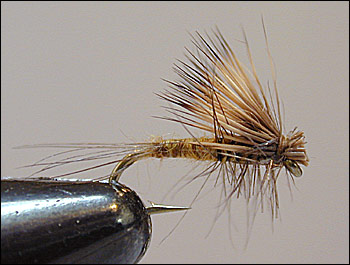
On The Fly
"Fly tying is a school from which we never graduate"
TYING NEWS
Some of you have heard of Project Healing Waters for military veterans. One of
our members, Morris Fruitman, taught the fly tying segment of this worthy program to fifteen
veterans at the VA Dom during July. Project Healing Waters was sponsored by the Southern Oregon
Fly Fishers and the VA. Classes were held once a week for four weeks and covered four basic
patterns -- the Wooly Bugger, Wooly Worm, Brindle Bug, and a Stillwater Leech. Other members
helping out were Joe Holzen, Dick Butler, and Tony Brauner. In Morris' words, "This turned out
to be a wonderful program and a great experience for both myself and the vets." Thank you,
Morris, for sharing the art.
The Southern Oregon Fly Tiers did not meet in August, but we will resume our
guest tier tie-along series on September 9th with David Roberts showing us a couple summer
steelhead patterns. I encourage novice and experienced tiers alike to drop by the second Tuesday
of each month at 6 p.m. for a fun evening. There is plenty of room for everyone. If you are
interested in this educational experience, contact me and we will add your name to our e-mail
notification list. We can let you know who, when, and what materials you should bring.
 PATTERN OF THE MONTH - Olive Hairwing Dun
PATTERN OF THE MONTH - Olive Hairwing Dun
Hook: Daiichi 1170 or equivalent standard dry fly hook, size 12-20.
Thread: Olive 8/0.
Tails: Blue dun hackle fibers, split.
Body: Olive fur or synthetic dubbing.
Hackle: Blue dun.
Wing: Gray-dyed yearling elk or coastal deer hair.
Tying Instructions:
1) Start the thread one eye-width back from the eye. Lay down a thread layer to a point just
above the barb.
2) Twist on a tiny amount of dubbing to form a small knot of fur at the bend of the hook.
3) Select two or three hackle barbs for each side of the tail. Tie them in on the back and front
side of the shank, in front of the fur knot you just formed. Make a couple of wraps back over
the fibers and up against the knot and this will keep the tail fibers splayed outwards. Trim the
butts.
4) Twist enough dubbing on your thread to form a slender, tapered body and wind the dubbing
forward to the midpoint of the hook. Tie-off and trim.
5) Select a hackle feather with fibers 1½ to 2 times as long as the gap of the hook. Strip the
webby fibers from the lower portion of the stem. Tie-in the stem, then trim the excess.
6) Twist dubbing onto the thread and wind the dubbing forward to form the thorax. Tie-off and
trim.
7) Wind five evenly spaced turns of hackle forward over the thorax. Tie-off and trim.
8) Select a small bunch of elk or deer hair, clean the fuzzy under-fur from the butts, and stack
the hair so that the tips are even. Measure so that the tips are equal to the body length and
tie the hair on top of the hook just behind the eye. Take eight-ten additional wraps toward the
rear, back over the wing while you hold the hair wing out of the way.
9) Pull the wing butts back from the hook eye; place a couple of whip finishes behind the eye,
clip the thread and apply cement.
10) Clip the hair butts straight across just in front of the hook eye. Clip a V-notch out of the
bottom of the hackle. You're done.
The whole category of Hairwing Duns was developed by Rene Harrop in the late 1980s. Unlike most mayfly dun imitations with the wing standing straight upright or tilted forward, this style shows a wing silhouette that is held upright but slanted back like the natural. The V-notch cut in the bottom of the hackle makes the fly very versatile. The fly floats flush in the surface film and is very imitative of the mayfly shape on smooth water but with its hackle and hairwing, it is an excellent design for fishing riffles and runs. Dave Hughes was asked, "If you could fish with just one fly, which would it be?" The Hairwing Dun was his choice.
TYING TIPS
1) When you apply dubbing to the thorax, make sure to taper it down to the hook eye. This will
give the wing the proper angle.
2) Size the bunch of hair to be used for the wing in proportion to the hook size. This amount
will be determined by "experience by the dozen."
3) When you use eight-ten thread wraps between the eye and the wing it gives a gap that keeps
the wing from flaring too much.
4) If you have a rotary vise, turn the fly over to clip the V-notch in the hackle bottom; if
otherwise, take the fly out of your vise and clip it by hand.
Variations are obvious, and size and color of materials will create an
imitation that is effective in almost any situation. If you enjoy matching hatches but want to
tie only one style of mayfly dun, this would be a good one. So, tie some up, give them a test
flight and let me know how you do.
Tie One On,
Dan Kellogg (you can contact me at FLYGUY@EZNORTHWEST.COM)